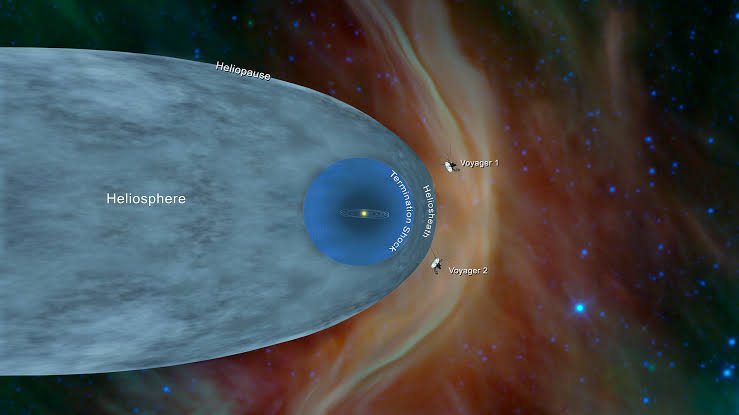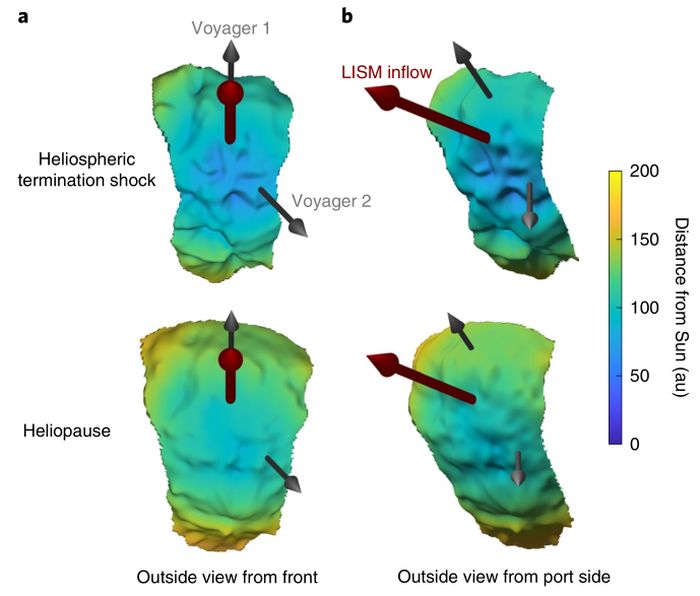It is possible that, at times, the space bubble enclosing the Solar System might be wrinkled. The termination shock and heliopause are shifting regions of space that serve as one of the boundaries between the Solar System and the interstellar region. Data from a spacecraft orbiting the Earth has revealed ripple structures in these regions.
The findings demonstrate that it is possible to have a thorough understanding of the Solar System’s periphery and how it evolves through time.
The Heliosphere

The Heliosphere, an area of space that extends from the Sun and protects the planets in our Solar System from cosmic radiation, will be better understood by scientists as a result of this information.
The Sun has a range of effects on the space surrounding it. It extends past the planets and the Kuiper Belt before fading out in the vast space between the stars.
What is termination shock?
The termination shock is the point at which this flow ceases to be fast enough to allow sound waves to pass through the diffuse interstellar medium, and the heliopause is the point at which it becomes too weak to push back against the extremely light interstellar pressure.
We now have the first in-situ observations of this morphing border because both Voyager probes have crossed the heliopause and are, in essence, traveling through interstellar space.
What is IBEX?
But since it began operating in 2009, NASA’s Interstellar Boundary Explorer has been another instrument in Earth orbit that has been assisting scientists in mapping the heliopause (IBEX).
When the solar wind from the Sun and the interstellar wind collide near the Solar System’s edge, energetic neutral atoms are produced that are what IBEX detects. Some of those atoms are thrown back to Earth, while others are launched farther into space.
Similar to cosmic echolocation, energetic neutral particles that come back to us can be used to map the form of the boundary after the power of the solar wind that produced them is taken into consideration.
On what did the previous map of the sphere depend?
Previous maps of the heliosphere’s structure depended on long-scale measurements of the evolution of solar wind pressure and energetic neutral atom emissions, which caused the boundary to become smoother across both time and space.
However, over the course of around six months in 2014, the dynamic pressure of the solar wind rose by about 50%.
The termination shock and heliopause were examined in greater detail using this short-scale event by a team of researchers led by Princeton University astrophysicist Eric Zirnstein. They discovered enormous ripples, on the scale of tens of astronomical units (one astronomical unit is the average distance between Earth and the Sun).
How to understand the high pressure wind?
In order to understand how this high-pressure wind interacted with the Solar System boundary, they also conducted modeling and simulations.
They discovered that the pressure front arrived at the termination shock in 2015, sending a pressure wave through the space known as the termination shock-heliopause transition area.
A storm of energetic neutral atoms that fills the inner heliosheath by the time the reflected wave returns to the termination shock occurs at the heliopause when a reflected wave travels back and collides with the still-incoming flow of charged plasma behind the pressure front.
Related: NASA’s Voyager-1 Sends Back Strange Data From Interstellar Space
What was the team’s observation?

The team’s findings also reveal a large shift in the heliopause distance. At a distance of 122 astronomical units, Voyager 1 passed through the heliopause in 2012.
Voyager 1 was 136 astronomical units from the sun in 2016, still in interstellar space, but with a growing heliosphere in its wake. In 2016, the team calculated the distance to the heliopause in its direction to be roughly 131 astronomical units.
In 2015, the team measured the distance to the heliopause in the direction of Voyager 2 at 103 astronomical units, with an error range of 8 astronomical units on either side. Voyager 2 was still inside the error margin at that time because it was just 109 astronomical units away from the Sun.
Conclusion
At a distance of 119 astronomical units, it didn’t cross the heliopause until 2018. Both observations imply that the heliopause’s geometry fluctuates, and not just slightly. It’s unclear why exactly.
To monitor energetic neutral atom emission more accurately and over a wider energy range, a new spacecraft will be launched in 2025.
That, according to the team, should assist to clarify some puzzling issues about the peculiar, unseen, “wrinkly” bubble that shields our small planetary system from the weirdness of space.
